- Established 1982 -HOME: www.hiltonpond.org
THIS WEEK at HILTON POND Subscribe for free to our award-winning nature newsletter (Back to Preceding Week; on to Next Week) |
2019 BIRD BANDING SUMMARY: --THUMBNAIL RESULTS-- At Hilton Pond Center we arbitrarily established 2,000 as a realistic round-number goal for how many birds we'd like to band each calendar year. We fell short in 2019, largely because of uncooperative weather, a relatively poor season for Ruby-throated Hummingbirds, and the non-arrival of winter finches this past fall. (Two bander lithotripsies did not help.) We finished the year with 1,560 bandings--below our desired minimum and less than our 38-year average of 1,834 individuals banded annually. All text, maps, charts & photos © Hilton Pond Center The just-ended year's biggest numbers came from five species (above, left to right from top): Purple Finch (348, ALL of which occurred January through March), American Goldfinch (240, but only three banded in fall or early winter); House Finch (221, undoubtedly local residents and their offspring); Ruby-throated Hummingbird (162, a disappointingly low number, below their long-term average for the first time since 2013); and Northern Cardinal (which rebounded nicely this year with 142 individuals, third highest total in 38 years). These five species alone combined for 1,113 individuals, or 71% of the 2019 yearly total. (Is it coincidental that four of the most commonly banded species have males that are red? Just wondering . . . .) In all, 67 species crossed our banding table in 2019--our highest total since back in 2004 and about half the 127 species banded locally since 1982--slightly above the 38-year average of 65. One bright spot: We did surpass the 69,000 total-bird mark in our 38th year of avian banding and research at Hilton Pond, reaching a grand total of 69,690 bandings by year's end. --END-OF-YEAR THANKS-- Hilton Pond Center for Piedmont Natural History and Operation RubyThroat: The Hummingbird Project could not implement its banding program and other initiatives without the generosity of individuals who donate in support of our work in environmental education, conservation, and natural history research. We acknowledge these financial gifts throughout the year at the end of each installment of "This Week at Hilton Pond." In 2019 we were particularly grateful for contributions from the following Top Tier Sustaining Donors: Hope Andresen, Marie Baumann, Lynn & Terral Jordan, Liz & Tom Schmid (former owners, High Point Wild Birds Unlimited), and Gail & Tom Walder. Sincere thanks to them and to everyone else for such thoughtful generosity. All text, maps, charts & photos © Hilton Pond Center --BACKGROUND INFO-- Through the years we have observed fewer and fewer birds free-flying at Hilton Pond Center, which certainly influences overall banding success; we can't band them if they're not here! Banding tallies in 2019 were appreciably lower not only because of many fewer winter finches that would have swelled our numbers but because weather during much of the year didn't allow us to deploy mist nets. Spring at the Center was quite rainy and summer was too hot and cloudless, followed by atypical windy conditions almost daily from July through September (as demonstrated below during one of our windier Operation RubyThroat expeditions to Costa Rica in 2012). Autumn brought unusually wet weather to the Center, making mist netting inadvisable for much of the period.
All text, maps, charts & photos © Hilton Pond Center For the sake of bird welfare we don't open our nets when it's too hot for us OR the birds (above 90 degrees or so) . . . or below 40 degrees . . or when it's windy . . or in the rain. Thus, weather limits our work, and climatic differences year-to-year at the Center have definite impact on banding results. On top of weather influences we sometimes miss banding days at the Center's because of off-grounds programs and workshops. In fact, banding activity at Hilton Pond shut down for 2-7 days on several occasions throughout the year when the bander was out of town for consulting work or speaking engagements. (NOTE: We don't complain about our off-site activities because they and on-site Guided Field Trips help generate much-needed revenue that allows us to operate Hilton Pond Center and Operation RubyThroat year-to-year on a shoestring.) Even though we were away from the Center numerous days, we doubt a full 12 months of banding birds this year would have enabled us to reach our all-time highs of 95 species and 4,061 individuals set 'way back in 1991. For most species, the birds just weren't here in 2019!
All text, maps, charts & photos © Hilton Pond Center In 2019 when we WERE present at the Center (see plat above) we almost always ran a few sunflower seed traps all day for songbirds (locations A, B & C); late March through mid-October we concentrated on trying to capture Ruby-throated Hummingbirds coming to sugar water traps dawn to dusk at those three locations. When weather and time allowed, we typically deployed 6-8 mist nets just outside our old farmhouse and office (larger red box on map) where we could keep a close eye on them. During spring and fall migration periods we sometimes ran additional nets--up to 12--at various spots along outlying nature trails (D thru Z), making frequent trips to check the nets for captures. We do not tally net- or trap-hours at Hilton Pond Center. We find this accounting too complicated because of the way we have to operate, so we can't compare actual "banding effort" from one year to the next. Despite any annual variations in bander activity, we believe things "average out" over time, and our long-term banding studies still help us gain better understanding of nature trends here in the Carolina Piedmont.
All text, maps, charts & photos © Hilton Pond Center Year-to-year differences in work-hours DO affect our banding results, but of greater significance is the way the landscape at Hilton Pond Center has changed during 38 years we've worked and resided here. When we purchased our 11-acre plot in 1982 it was almost all open, the result of a century of agriculture that apparently involved cattle grazing and row crops such as cotton (above), corn, tobacco, and soybeans. We decided early on we would NOT be spending our time--or wasting energy or natural resources--cutting 11 acres of grass. Thus, we allowed the land to "go fallow," maintaining only a couple of small "meadows" and three-foot-wide, easily navigable nature trails that meander for nearly two-and-a-half miles around the property.
All text, maps, charts & photos © Hilton Pond Center Under our laissez-fair philosophy of land management, vegetational succession ensued and local habitats passed through stages, first from old field to shrubland--mostly invasives such as Chinese Privet and Russian Olive--and then to a dense stand of Eastern Red Cedar by about the 12th year. By Year 20 or so, most cedars were shaded out by deciduous trees, transitioning to our current young forest of pine and sundry hardwoods with minimal shrubs or herbaceous ground cover. An aerial photo of Hilton Pond Center from March 2012 (above) shows how thoroughly the land has become covered by woody vegetation--mostly fast-growing Loblolly Pines on the north edge, and hardwoods between the two ponds and on the southern half and eastern end of the property.
All text, maps, charts & photos © Hilton Pond Center Deciduous trees these days at the Center are primarily Winged Elm and Sweetgum, with a scattering of Black Cherry, Green Ash, Hackberry, Flowering Dogwood, and various oaks and hickories. Just as vegetation has changed (current photo, above), so has local bird life; with regard to banding, many species that hung out in vegetation close to the ground where our mist nets could snare them now fly uncaptured in treetops high above.
All text, maps, charts & photos © Hilton Pond Center Speaking of vegetational change, Google Earth posted an aerial image from March 2018 that shows Hilton Pond Center's farmhouse and the massive 150-year-old White Oak (above left) that toppled in October 2014. We feel quite certain loss of this ancient canopy tree had a negative impact on Center avifauna, but it was a natural occurrence. On the positive side, the big oak's absence has created a "hole in the sky" that provides a better view of sunsets AND of birds flying over.
All text, maps, charts & photos © Hilton Pond Center Incidentally, on a year-round basis we offer local birds a LOT of food, primarily black oil sunflower seeds (above, with American Goldfinch, Carolina Chickadee, and Eastern Tufted Titmouse), plus white millet, cracked corn, shell corn, safflower, thistle (Nyger), dried mealworms, bark butter, shelled and unshelled peanuts, and various suet blocks. Our experiments with orange slices and grape jelly have failed to attract anything, including orioles. Spring through fall we hang at least two dozen feeders with sugar water for Ruby-throated Hummingbirds; in anticipation of western vagrant hummer species, we maintain a couple of these even during winter. (We have captured and banded two fall Rufous Hummingbirds locally through the years, one of which showed up a year later in Ohio!)
All text, maps, charts & photos © Hilton Pond Center Of equal or even greater importance than feeders, Hilton Pond itself and several smaller artificial pools near the old farmhouse provide places for birds and other wildlife to drink and bathe. Accessible clean water often brings in more birds than does food--especially in winter when some drinking sources are frozen solid. This is why at least one of our artificial water features is always equipped with a cold-weather heater (above, with three Eastern Bluebirds, a House Finch, two Northern Cardinals, and an American Goldfinch). All text, maps, charts & photos © Hilton Pond Center --2019 BANDING DETAILS-- All text, maps, charts & photos © Hilton Pond Center (Click on chart above for a larger version in a new browser window) As depicted on the chart above (click on it and any chart below to open a larger version in a new browser window), 2019 ended with 1,560 birds banded from 67 species for Hilton Pond Center. These numbers were well below the 38-year average of 1,833.9 individuals (dotted white line) and the species average of 65. (Dotted red and blue trend lines on the chart show an on-going decline in both these categories.) This year's bird total was less than a third of what we caught in our biggest year of 1991 (4,061 individuals), and diversity in 2019 didn't come close to the 95 species we caught that same year. At least some of this discrepancy between decades is due to a big shift in vegetational cover noted above; it was in the mid-1990s when the Center's previously open areas were becoming dominated by tall shrubs and young trees. It's likely epidemic West Nile Virus in that decade also took its toll, especially on birds such as Blue Jays, Eastern Towhees, Northern Cardinals, and various sparrows. (Surveys in many locales near and far show fewer birds in the world due to diverse factors, from uncontrolled hunting to environmental toxins, and from climate change to devastatingly efficient free-roaming cats. But, as always, the biggest problem appears to be human-generated habitat loss.)
All text, maps, charts & photos © Hilton Pond Center These days, shrub-loving birds like Eastern Towhees (adult male, above), Gray Catbirds, Brown Thrashers, and many sparrows are quite scarce around Hilton Pond. Species like these that prosper along edges and in shrub-dominant landscapes rather than in woodlands or open meadows showed drastically diminished numbers after peaking during the "shrubby years" of the early 1990s. And Eastern Red Cedars--wth dense foliage that provided shelter, nesting habitat, and berries for many species--got shaded out by successive hardwoods, perhaps leading to further avian decline. All text, maps, charts & photos © Hilton Pond Center (Click on chart above for a larger version in a new browser window) We're happy to report that during the past three years Northern Cardinals showed a remarkable and steady rebound, culminating with 102 banded in 2019--our third best year ever (see chart above). This was nearly twice the average of 56 bandings for the preceding seven years and well above the 38-year average of 77. All text, maps, charts & photos © Hilton Pond Center (Click on chart above for a larger version in a new browser window) Ground-feeding Eastern Towhees were still in short supply in 2018 (see chart above), with only six banded--compared to 85 in 1991 and a long-term average of 19. Brown Thrashers (see chart below) showed a remarkably similar decline from which they have not rebounded, with this year's seven bandings below average and a faint reminder of the 59 banded in 1993. All text, maps, charts & photos © Hilton Pond Center (Click on chart above for a larger version in a new browser window) To re-emphasize our point, we include charts above for all three of these species because they are ground feeders and low nesters that tend to be successful when there are lots of shrubs available; they also seem to have been hit hard by West Nile Virus (WNV) in the mid-1990s. As noted, shrubs at Hilton Pond Center essentially disappeared as natural succession gave rise to mixed woodland; we do not know how prevalent WNV might still be, but some bird species undoubtedly have developed at least some resistance. We have no hypothesis to explain what enabled Northern Cardinals to rebound while towhees and thrashers remain at very low local levels. Your speculation is welcome at INFO.
All text, maps, charts & photos © Hilton Pond Center It did not help our local bird life that back in 1995 an adjoining farmer to the north of the Center clear-cut about 45 acres of mature Loblolly Pines and converted his land to pasture for beef cattle (see aerial image above). This brought about a nearly instantaneous drop in numbers of species that nest, feed, roost, or winter in pine lands, and populations declined drastically among numerous breeding species. All text, maps, charts & photos © Hilton Pond Center (Click on chart above for a larger version in a new browser window) Blue Jays and other corvids were among those birds hit hard by West Nile Virus, so we were pleased this year (and last) to see a moderate increase in local numbers with 12 banded both years. If anything, our Hilton Pond habitat should be getting better each year for Blue Jays, what with the increasing abundance of wild nuts and acorns and plenty of nesting sites in the hardwoods. All text, maps, charts & photos © Hilton Pond Center (Click on chart above for a larger version in a new browser window) Despite habitat disruption and vegetation change, we continue to capture a significant number of birds at Hilton Pond Center. As shown on the chart above, the Center's 26 most commonly banded species continue to be dominated by four "winter finches," plus Ruby-throated Hummingbirds (see chart above). Three of those--American Goldfinch (11,465 bandings), House Finch (10,817), and Purple Finch (8,994) are remarkably close in number after 38 years; since leaping atop the totals list in 2014, goldfinches have kept the lead. All text, maps, charts & photos © Hilton Pond Center (Click on chart above for a larger version in a new browser window) Despite their position atop the list, goldfinches put in a relatively poor showing in 2019 with just 240 banded--less than the 38-year average of 302 and considerably below the all-time high of 838 in 2007. Of those AMGO this year, only three were banded in Autumn 2019; we suspect the ones captured January through May at Hilton Pond Center were nearly all migrants from up north. Purple Finches did quite well January-March, with 348 bandings well above the average of 237, but they failed to appear this fall. Pine Siskins--the most unpredictable of the four finch species--have barely shown up the past four years; we banded only 16 total 2016-2019 (just three in mid-March this year), which was especially surprising after we handled a record high of 770 in the irruptive year of 2015!
All text, maps, charts & photos © Hilton Pond Center NOTE: American Goldfinches, Purple Finches, and Pine Siskins (above) that breed in Canada and the northern tier of the U.S. are not obligate migrants; i.e., they typically migrate only during those winters when food is scarce. Canada has an abundant crop of seeds in 2019, so AMGO, PUFI, and PISI had yet to come south by the end of December 2019. A few PUFI from the Carolinas were reported on eBird in Nov- Dec 2019, but we suspect these were misidentified House Finches. All text, maps, charts & photos © Hilton Pond Center (Click on chart above for a larger version in a new browser window) The House Finch population at Hilton Pond Center has stabilized in the past two decades after reaching highs in the mid-1980s through early 1990s (see chart above). During that period nearly all eastern HOFI were winter migrants from up north, their direct ancestors having been released on Long Island in 1940-41. House Finches are native to the western U.S. but in the East have expanded in all directions from that original New York population. They are now established breeders in the Carolina Piedmont and are nearly ubiquitous in the lower 48 states. In 2019 we banded 221 House Finches, down from the 38-year average of 284.
All text, maps, charts & photos © Hilton Pond Center One House Finch we banded in 2019 (above) was "calico," with atypical red and gold plumage. HOFI males acquire their red feathers by the end of their first autumn, but old females sometimes take on a reddish or yellowish hue. This bird had extensive color and was a second-year bird--one that hatched in 2018--so we concluded he was a male that didn't lay down enough red pigment. It will be interesting to recapture him after he's molted to see if he acquires his expected full red plumage.
All text, maps, charts & photos © Hilton Pond Center Folks often ask: "What's the most unusual bird you banded this year at Hilton Pond Center?" We're never quite sure how to answer except to look at numbers and respond with the name of a bird we seldom band. Using that criterion, the Red-headed Woodpecker (above) captured on 4 April would be 2019's "biggest rarity"--mostly because it was the FIRST ever banded locally --and just the third local sighting in 38 years! This striking tricolored woodpecker brought the Center's overall banding total to 127 species.
All text, maps, charts & photos © Hilton Pond Center And speaking of woodpeckers, on 6 April 2019 we captured nine Downy Woodpeckers (adult male, above). Of these, four were new; from the remaining five, three were banded last year, one in 2017, and one—by then a fourth-year bird—from 2016. Amazingly, SEVEN were females and ALL were in breeding condition with well-developed brood patches indicating they were incubating eggs, or possibly already sitting on young chicks. Assuming DOWO have long-term monogamous pair bonds—which reportedly is the case—each of those seven females must have a male out there, which in turn means in April there were at least SEVEN pairs of Downy Woodpeckers at or very near Hilton Pond Center.
All text, maps, charts & photos © Hilton Pond Center As an example of what fall banding days can be like, we ran mist nets dawn to dusk at the Center on 6 October 2019 and had what was probably our most diverse banding effort of the year: 25 individuals and 12 species. Here's the list: 6 American Redstarts
All text, maps, charts & photos © Hilton Pond Center Among the 67 species banded in 2019, there were 14 species for which we caught just one individual: Sharp-shinned Hawk (above, 40th banded since 1982), Red-headed Woodpecker (first-ever), Hairy Woodpecker (28), Golden-crowned Kinglet (165), Veery (101), Northern Mockingbird (179), Fox Sparrow (46), Rose-breasted Grosbeak (56), and five warblers: Bay-breasted (18), Black-and-white (183), Hooded (55), Northern Parula (75), and Yellow-throated (12). Of these, most would not qualify as particularly "unusual." Based purely on numbers through the years the Red-headed Woodpecker, Bay-breasted Warbler, and Yellow-throated Warbler (this year's female, below) were the "rarest" of the bunch. (The table at the end of this write-up includes all species captured at the Center and how many of each we banded in 2019.)
All text, maps, charts & photos © Hilton Pond Center We had several other "underachieving" species this year at Hilton Pond Center. For example, we banded just five wintering Dark-eyed Juncos in 2019--even though it has been our 13th-most-common species with 845 banded. Likewise, 8th-most-common Yellow-rumped Warblers (2,317 since 1982) were barely present with only 20 banded this year, (Where HAVE all the juncos and butterbutts gone?) Also elusive or absent--along with several others among our top 26 species with more than 400 bandings: Common Grackle (NONE banded), Magnolia Warbler (two), and five each for Swainson's Thrush, Ruby-crowned Kinglet, and Gray Catbird. All text, maps, charts & photos © Hilton Pond Center (Click on chart above for a larger version in a new browser window) In 2019, we had 28 species for which bandings equaled or surpassed their 38-year AVERAGE. No species was banded often enough in 2019 to surpass its 38-year MAXIMUM--although As noted earlier, Northern Cardinals came close (142 banded with an all-time record of 157). Closer still were Mourning Doves (see chart above) whose 42 bandings in 2019 tied with 2013 but ended up short of the record 44 from 2009). And then there was the diminutive Winter Wren (below), for which the two we caught this year equaled their annual high from three previous years. (NOTE: This year's two WIWR were just our 15th and 16th since 1982.)
All text, maps, charts & photos © Hilton Pond Center --2018 FOREIGN ENCOUNTERS, RETURNS & RECAPTURES-- Northern Cardinals, Carolina Chickadees, Tufted Titmice, Carolina Wrens, and Mourning Doves, among others, are year-round residents at Hilton Pond Center. We recapture many of them over and over again after banding. Other species are non-residents that migrate away after banding and return in a later season as excellent examples of precise site fidelity.
All text, maps, charts & photos © Hilton Pond Center Our furthest known flier on record was a brown Purple Finch (file photo above) of unknown age banded at the Center in Feb 2004 and encountered two months later at Monastery, Nova Scotia--where it had been killed by a cat. This was a sad way to end a northbound migration route that covered at least 1,275 air miles. Despite banding 69,690 birds during nearly four decades at Hilton Pond Center, only 64 individuals (14 species) have been encountered outside our home county of York, while an additional 39 (13 species) were reported from within the county. (Click on links to review either list.) We speculate such low foreign encounter rates are due in part to a relative scarcity of banders in the southeastern U.S. and because of the mostly rural nature of both Carolinas; fewer banders, fewer people, and large swaths of undeveloped land mean banded birds are less likely to be encountered.
All text, maps, charts & photos © Hilton Pond Center This year (2019) one of our banded birds from Hilton Pond Center was a "foreign encounter" found outside York County and reported to the federal Bird Banding Lab. The report was especially interesting for a couple of reasons, not the least being it documented an encounter in Haines Lake, Ontario--a long way almost due north of Hilton Pond (see map below). In this case Rhonda Murphy had seen a banded female American Goldfinch at her feeder in Canada and managed to use skill, patience, and camera to get images of the bird's right leg. Rhonda's photo series allowed her to determine the complete number was 2870-24073, which she reported on 20 May 2019 via the Bird Banding Lab's on-line page. In response to our inquiry, Rhonda e-mailed us these details:
After her report was filed, the Lab informed Rhonda we had trapped and banded the goldfinch just five months previous (24 January) here at the Center, undoubtedly when the bird was still on its wintering grounds. Sometime between then and May this goldfinch traveled at least 718 straight-line air miles, returning to an area in Ontario (see map below)--probably near where she hatched and where she would be ready to mate in the summer of 2019. This was an astounding trip for a bird that weighs only half an ounce (~15 grams).
All text, maps, charts & photos © Hilton Pond Center Thanks to Rhonda Murphy for her persistence in determining the bird's band number, for reporting her encounter to the Bird Banding Lab, and for providing us with her photo above of this far-flying female American Goldfinch at a feeder in bright breeding plumage.
All text, maps, charts & photos © Hilton Pond Center We also had two banded birds from the Center reported from within York County. The first was a female Mourning Dove (above) banded here as a second-year bird on 29 March 2016 was shot on New Year's Day 2019. She was in her fifth year at the time of her demise in a dove field less than two miles from the Center. (We are not anti-hunting, but we are concerned this particular bird was shot illegally, out of season.) A second dead bird reported was a House Finch that hit a window and died in March 2019 less than half a mile from Hilton Pond, four months after banding.
All text, maps, charts & photos © Hilton Pond Center Although we have a low foreign encounter rate, many migratory birds banded at Hilton Pond Center have returned here in later years, providing valuable information about species longevity and site fidelity. (Of 127 species banded locally, 62 species have been recaptured locally in a later year.) Most notable was a Purple Finch--banded as unknown age and sex on 13 March 2009--that returned and was recaptured on 20 February 2017. By then he bore red plumage (see photo above), meaning he was a male that must have hatched in 2009--a TENTH year bird. (The longevity record for PUFI is 12 years 8 months.) Some of Hilton Pond Center's more noteworthy recaptures/returns in 2019 are described below. (Ruby-throated Hummingbird returns are discussed in a later section.) The oldest bird encountered this year is among our oldest on record for the Center: A male Northern Cardinal (file photo below) mist netted and banded on 24 June 2011 as a recent fledgling was netting again almost exactly nine years later on 15 June--meaning he was a 9th-year bird in 2019; he is undoubtedly a local resident. (Known longevity record for a free-flying wild NOCA is 15 years nine months.)
All text, maps, charts & photos © Hilton Pond Center Here are some of Hilton Pond Center's other returns/recaptures of particular interest from the calendar year just completed:
All text, maps, charts & photos © Hilton Pond Center Although returns and local recaptures of birds banded at Hilton Pond Center frequently occur, foreign encounters of our birds are few. Even less common are recaptures here of birds banded elsewhere by someone else. Prior to this year we had re-trapped only eight foreign birds--four Purple Finches, three House Finches, and one American Goldfinch--all but one of these eight from banding stations far northeast of York SC. (For a complete list, see Birds Banded Elsewhere and Recaptured at Hilton Pond.) On 18 March 2019 we caught an already-banded brown Purple Finch in a trap with several unbanded ones. (See our photo above of the bird in question.) We carefully read its number as 2521-54988 and realized it belonged to another bander, so we went on-line to enter the sequence into the Report Band Web site of the federal Bird Banding Laboratory. The near-instant reply: "Purple Finch #2521-54988 was banded as a hatch-year bird of unknown sex on 18 October 2018 under the permit of Dr. Peter W. Paton near Kingston, Rhode Island!"
All text, maps, charts & photos © Hilton Pond Center Through later correspondence we learned a bander working under Dr. Paton had caught this PUFI at a field station connected with the University of Rhode Island--692 miles from Hilton Pond (see map above). This Purple Finch encounter was the furthest we've had someone's banded bird travel before being recaptured here--cause for jubilation on both ends of this bird's long migratory path. All text, maps, charts & photos © Hilton Pond Center ••2019 RUBY-THROATED HUMMINGBIRDS•• All text, maps, charts & photos © Hilton Pond Center (Click on chart above for a larger version in a new browser window) Because Ruby-throated Hummingbirds are a primary research interest here and in Central America, we were disappointed with how things went in 2019 at Hilton Pond Center. After a phenomenal record-breaking year in 2016 (see chart above)--when our 373 RTHU bandings obliterated the previous high of 246--this year brought us our second-lowest total in the past 16, with just 162 hummers banded; this was below our 36-year average of 176.5. (Note: Although we have been banding at Hilton Pond since 1982, we did not receive authorization to band hummingbirds until 1984.) All text, maps, charts & photos © Hilton Pond Center (Click on chart above for a larger version in a new browser window) The 2019 Ruby-throated Hummingbird research season started very slowly at Hilton Pond Center; its progress is marked by the red dotted line on the chart above. Our first new capture of an adult male RTHU (see photo below) on 2 May was nearly TWO MONTHS later than our early record of 27 March (in four different years), and our first adult female did not arrive until 24 May. By the end of April we had banded only 13 ruby-throats; this was an incredibly slow start to the hummingbird banding season, and things never really got going in 2019.
All text, maps, charts & photos © Hilton Pond Center The white dotted line on the chart above represents average day-to-day hummingbird banding progress through the years at the Center. In 2019 things did not start to pick up until mid-July, and new hummer activity did not accelerate as usual. By the end of that month our 2019 Ruby-throated Hummingbird bandings was a mere 73, nearly half of what we would catch that whole season. Our best day for banding ruby-throats in 2019 was 9 July, when we caught six. (This is far below our one-day record of 26 banded 'way back on 30 May 1997.) Oddly, we banded no RTHU in October--in fact, none after 26 September. The first 2019 return of a BANDED RTHU was an adult male on 2 April. The first returning female arrived two weeks later on 17 April. (In light of all these arrival dates for new and returning Ruby-throated Hummingbirds, we always suggest folks in our region hang--and maintain--at least one sugar water feeder by 15 March each year. Better to be early than too late.)
All text, maps, charts & photos © Hilton Pond Center All Ruby-throated Hummingbirds captured--or recaptured--at Hilton Pond Center are banded and then marked with a temporary green color mark (see female above). This helps us avoid recapturing "trap junkie" hummers that re-enter our pull-string traps over and over and over again. In spring it also means folks north of us can be alert for color-marked RTHU; in autumn observers to our south can be on the lookout. If you see ANY color-marked hummingbird, please report it to us immediately via e-mail at RESEARCH; a photo would be most helpful. All text, maps, charts & photos © Hilton Pond Center (Click on chart above for a larger version in a new browser window) By the end of any given breeding season at Hilton Pond Center we would logically expect many more hatch-year RTHU among our banded birds. With each female typically producing two fledglings, the population theoretically should at least double. (In reality, reproductive output of Ruby-throated Hummingbirds is far more complex; with double-brooding possible and at least some males having a harem system with more than one female, at most latitudes the local population could more than double during the breeding season--assuming good fledgling survival prior to migration.) During 36 years of hummer banding (left pie chart, above), 71.8% of all ruby-throats banded have been recent fledglings; in 2019 (right pie chart) they made up a very similar 74%. Our 48 hatch year males (pale blue on charts above) made up 30% of all bandings in 2019--significantly below the 36-year average of 42.4%; thus, our 72 young females (pink on charts) resulted in a much higher percentage of all birds (44%). In 36 years of studying RTHU at Hilton Pond Center, we have NEVER had more young females than males that had always been the largest of the four age/sex classes. We are at a loss to explain how our results were so skewed in 2019. Again, your speculation is welcome at INFO. Note that percentages for 16 adult males (10%; dark blue on charts) and 26 females (16%; in red) were very close to average, although the actual numbers of captures were well below the norm.
All text, maps, charts & photos © Hilton Pond Center Lower numbers of banded youngsters (immature male above, color-marked and with incomplete red gorget) suggests the breeding season at Hilton Pond Center was much less successful than usual for Ruby-throated Hummingbirds, and maybe elsewhere. Again, we can't explain this year's uncharacteristic scarcity of hatch-year birds. All text, maps, charts & photos © Hilton Pond Center (Click on chart above for a larger version in a new browser window) Although the Center's crop of NEW Ruby-throated Hummingbirds was indeed sparse in 2019, it was our third-best year for RETURNS of RTHU banded in previous breeding seasons (see chart above). In fact, our 56 "old birds" was nearly twice the 35-year average of 30.8. We did anticipate a bumper crop of returns in 2019 because of the record-breaking numbers of RTHU we banded during the preceding three breding seasons. The dotted red trend line on the chart above shows RTHU returns are generally increasing at Hilton Pond Center--to be expected because our numbers of new bandings are also on the rise. On average, about 11% of all ruby-throats we band locally return in at least one later year--a substantial subset when we consider that an estimated 60% to 80% of young hummers produced each year do not survive due to disease, genetic defects, predators, environmental dangers, and rigors of migration down and back. (It may also be that some Ruby-throated Hummingbirds banded at the Center disperse to other nearby areas, never again to be seen locally after banding.)
All text, maps, charts & photos © Hilton Pond Center Of this year's 56 RTHU returns at Hilton Pond Center (see list below), 29 were banded last year (2018), 14 in 2017, ten in 2016, and three in 2015. The apparent oldest were two after-fifth-year females banded as adults in 2015 and now in at least their sixth year. (It's entirely possible either of these could actually have been years older than that since the Bird Banding Lab's record for oldest free-flying Ruby-throated Hummingbird is 9+ years.) A third female banded locally in 2015 hatched that summer and was banded as an immature, so we know her age for sure to be five years. (Note that this latter individual, #81349, was not recaptured in 2017 but reappeared the following two years. Several other birds on the list were also absent from our nets and traps in one year or another, only to show up again later on. Because Ruby-throated Hummingbirds show strong site fidelity to their natal/breeding grounds, it's likely these hummers were in the neighborhood each year and simply avoided recapture.) ••"Old" Ruby-throated Hummingbirds Returning in 2019••
It is interesting that only two of the "old" returning hummingbirds listed above are males. We can think of several possible explanations (or combinations thereof) for this gender-related discrepancy: 1) "Old" males are "smart" enough to avoid the hummingbird traps with which we capture--and recapture--the majority of our ruby-throats at Hilton Pond Center; 2) Male hummingbirds survive at lower rate than do females and thus are unable to return for recapture; 3) Males may disperse to other locations--perhaps because of territorial disputes--thus avoiding local recapture; and, 4) Or something else entirely. We'd be happy to hear your hypothesis on what might be happening here; just send an e-mail to INFO. One other note of interest about RTHU returns: Very few hummers we band at Hilton Pond in September or October end up returning in a later year.
All text, maps, charts & photos © Hilton Pond Center We have banded 6,355 Ruby-throated Hummingbirds since 1984 and have 1,022 total returns, with some individuals returning in more than one later year. Alas, only six of our Hilton Pond hummers have been seen elsewhere. Four color-marked RTHU were encountered during fall migration (see map above) in Atlanta, Louisiana, and Alabama (two individuals). Two spring migrants were reported from Massachusetts and Clover SC (the latter about ten miles north of the Center). All text, maps, charts & photos © Hilton Pond Center
All text, maps, charts & photos © Hilton Pond Center ••2019 "YARD LIST" & NESTING SPECIES•• Our "Yard List" of birds observed through the years on or over Hilton Pond Center remained at 171 through 2019, the most recent new YARD species coming six years ago when we observed (and banded) eight Savannah Sparrows during a January 2011 snowstorm (see photo above). Our newest BANDED species--#127--was the Red-headed Woodpecker in April of this year. During 2019 we saw or heard a total of 95 bird species--one short of our record set in 2008. This year's tally was 19 more than last year and represented about half (56%) of the species observed locally since 1982.
All text, maps, charts & photos © Hilton Pond Center We find it interesting that of 38 North American Wood Warblers LIKELY to be seen at Hilton Pond Center, we have observed and banded 35 of them. The missing species are Cerulean Warbler (second-year male, above, which we banded in West Virginia this year) and Mourning Warbler--both of which typically migrate further inland and west of the Center--and the endangered Kirtland's Warbler. (The other 14 extant North American parulids are western species not likely to occur in South Carolina's Piedmont Province. Bachman's Warbler--now extinct from the Carolina Lowcountry and elsewhere--can no longer be seen except in museums.)
All text, maps, charts & photos © Hilton Pond Center Among all species encountered at the Center since 1982 we've found nests for 25, including other birds that often lay their eggs in a box intended for Eastern Bluebirds (winter male and female above). A male Prothonotary Warbler even tried building a nest in a box with 1.5" hole before a dominant bluebird pair drove him away. All our boxes have been pretty effective and have been used by Tufted Titmice, House Wrens, and Carolina Chickadees. We've also installed several boxes with 1" diameter holes that exclude bluebirds but allow Brown-headed Nuthatches to enter. The boxes stay up year-round and sometimes serve as roost sites during cold weather; they occasionally are occupied by Southern Flying Squirrels.
All text, maps, charts & photos © Hilton Pond Center We have six much-larger nest boxes mounted on poles in the water at Hilton Pond itself. Complete with predator baffles, these structures are designed for Wood Ducks and have produced more than 750 ducklings since 1982 (see image above of perched hen with watchful drake swimming on Hilton Pond). NOTE: If you're not keeping a Yard List for your own property we encourage you to do so, and to report your sightings via eBird. The eBird Web site provides a great way for you to keep track of what you see and when, and it allows you to make valuable contributions to our body of knowledge about birds. You, too, can be a "citizen scientist." All text, maps, charts & photos © Hilton Pond Center ••2019 BANDING TOTALS•• A complete list of 1,560 birds of 67 species banded at Hilton Pond Center in 2019 is provided in the table below. Also shown are our 38-year maximums, averages, and grand totals for each species. Among those species banded this year we set one new record high by default (our first Red-headed Woodpecker) and tied one existing high (two Winter Wrens). For each of 28 species (green type in the table) we banded a number at or above its 38-year-average. The remaining 138 species (black type) came in with below-average numbers this year, or with none banded at all.
All text, maps, charts & photos © Hilton Pond Center We invite you to examine and dissect the table below for trends or to see whether we captured your favorite species--perhaps a White-breasted Nuthatch (banded male, above, with very black cap). For a running account of banding and recapture results for the just-completed year, please refer to lists at the end of each installment of "This Week at Hilton Pond," beginning with the one for 1-31 January 2019. There really is much to be said for long-term banding projects like ours that provide solid baseline data leading to better understanding of avian ecology. We're proud to report we've been at it since 1982 at Hilton Pond Center for Piedmont Natural History--still the most active year-round bird banding station in the Carolinas. All text, maps, charts & photos © Hilton Pond Center
TABLE 1: ANNUAL (2019) & CUMULATIVE (38-year)
All text, maps, charts & photos © Hilton Pond Center
Checks also can be sent to Hilton Pond Center at: All contributions are tax-deductible on your Don't forget to scroll down for Nature Notes & Photos, |
|---|
"This Week at Hilton Pond" is written and photographed by Bill Hilton Jr., executive director of Hilton Pond Center for Piedmont Natural History |
|
Please refer "This Week at Hilton Pond" to others by clicking on this button: |
Comments or questions about this week's installment? Send an E-mail to INFO. (Be sure to scroll down for a tally of birds banded/recaptured during the period, plus other nature notes.) |

Click on image at right for live Web cam of Hilton Pond,
plus daily weather summary
Transmission of weather data from Hilton Pond Center via WeatherSnoop for Mac.
--SEARCH OUR SITE-- For your very own on-line subscription to "This Week at Hilton Pond," |
Thanks to the following fine folks for recent gifts in support of Hilton Pond Center for Piedmont Natural History and/or Operation RubyThroat: The Hummingbird Project. Your tax-deductible contributions allow us, among other things, to continue writing, photographing, and sharing "This Week at Hilton Pond" with students, teachers, and the general public. Please see Support or scroll below if you'd like to make a gift of your own. We're pleased folks are thinking about the work of the Center and making donations. Those listed below made contributions received during the period. Please join them if you can in coming weeks. Gifts can be made via PayPal (funding@hiltonpond.org); credit card via Network for Good (see link below); or personal check (c/o Hilton Pond Center, 1432 DeVinney Road, York SC 29745). You can also donate through our Facebook fundraising page. The following made contributions to Hilton Pond Center on 31 December 2018:
We are ever grateful for the many followers of Hilton Pond Center's Facebook page who made on-line contributions in 2019 by clicking on the "Donate" button. We acknowledged each of you in previous installments. Without these generous gifts the non-profit Center would be unable to continue its interrelated programs in environmental education, conservation, and natural history research. The following supporters made donations on 31 Dec 2019; some may be repeat contributors via Facebook: Nancy Biggins, Steve Dingeldein, Laura Hartley
|
If you enjoy "This Week at Hilton Pond," please help support Hilton Pond Center for Piedmont Natural History. It's painless, and YOU can make a difference! (Just CLICK on a logo below or send a check if you like; see Support for address.) |
|
Make credit card donations on-line via Network for Good: |
|
Use your PayPal account to make direct donations: |
|
If you like shopping on-line please become a member of iGive, through which 1,800+ on-line stores from Amazon to Lands' End and even iTunes donate a percentage of your purchase price to support Hilton Pond Center.  Every new member who registers with iGive and makes a purchase through them earns an ADDITIONAL $5 for the Center. You can even do Web searches through iGive and earn a penny per search--sometimes TWO--for the cause! Please enroll by going to the iGive Web site. It's a painless, important way for YOU to support our on-going work in conservation, education, and research. Add the iGive Toolbar to your browser and register Operation RubyThroat as your preferred charity to make it even easier to help Hilton Pond Center when you shop. Every new member who registers with iGive and makes a purchase through them earns an ADDITIONAL $5 for the Center. You can even do Web searches through iGive and earn a penny per search--sometimes TWO--for the cause! Please enroll by going to the iGive Web site. It's a painless, important way for YOU to support our on-going work in conservation, education, and research. Add the iGive Toolbar to your browser and register Operation RubyThroat as your preferred charity to make it even easier to help Hilton Pond Center when you shop. |
|
BIRDS BANDED THIS WEEK at |
|
SPECIES BANDED THIS PERIOD: * = new banded species for 2019 PERIOD BANDING TOTAL: 2019 BANDING TOTAL: 38-YEAR BANDING GRAND TOTAL: (Banding began 28 June 1982; since then 171 species have been observed on or over the property.) 127 species banded 69,690 individuals banded Ruby-throated Hummingbirds = 6,355 NOTABLE RECAPTURES THIS WEEK: |
OTHER NATURE NOTES: --Our immediate past installment of "This Week at Hilton Pond" was a summary report for the 29th annual York/Rock Hill (SC) Christmas Bird Count and is always available on the Center's Web site as Installment #708. All text & photos © Hilton Pond Center |
(immature male Rufous Hummingbird at right) |
(Back to Preceding Week; on to Next Week) Back to "This Week at Hilton Pond" Main Current Weather Conditions at Hilton Pond Center The Center's backyard Web cam at Weather Underground |
|

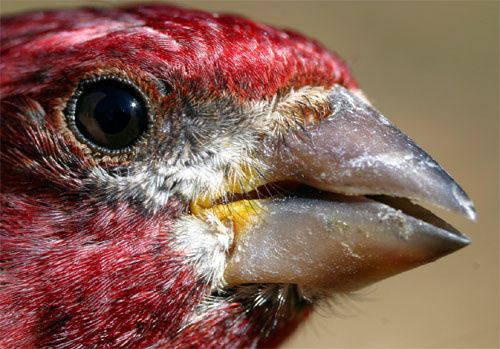
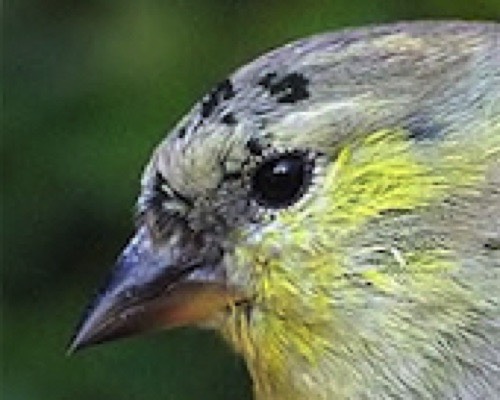
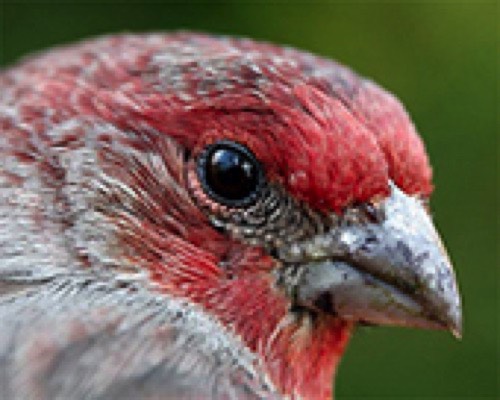
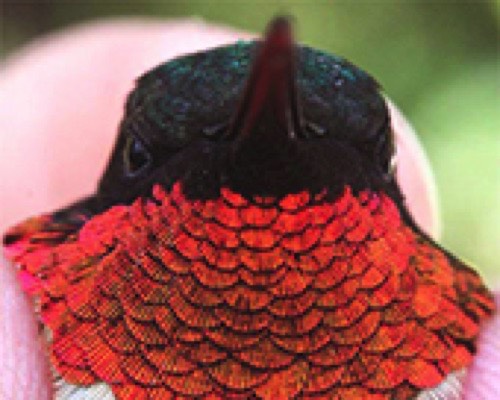
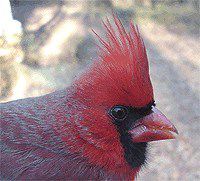
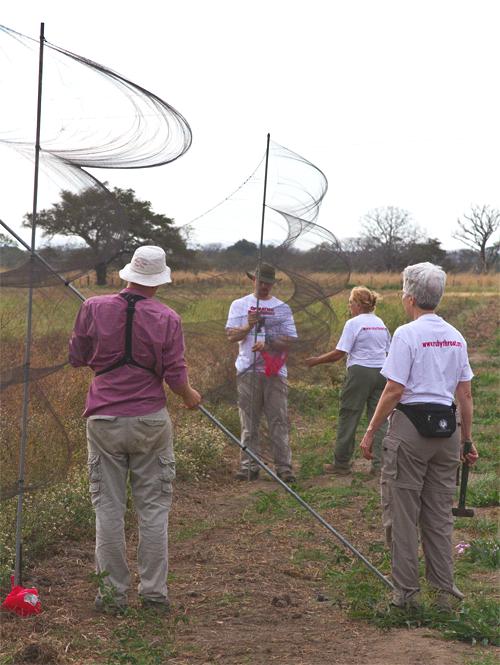
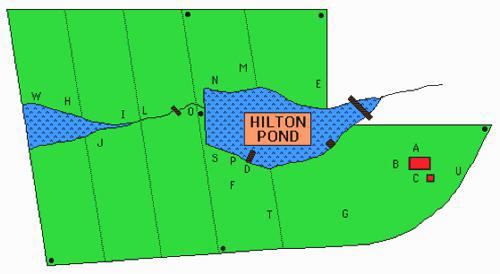
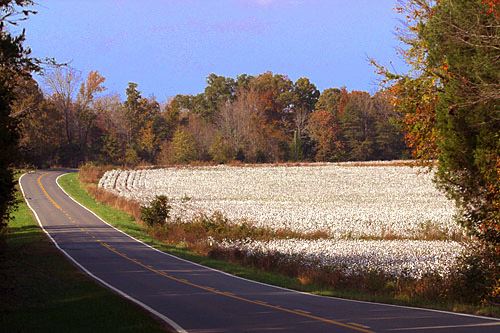

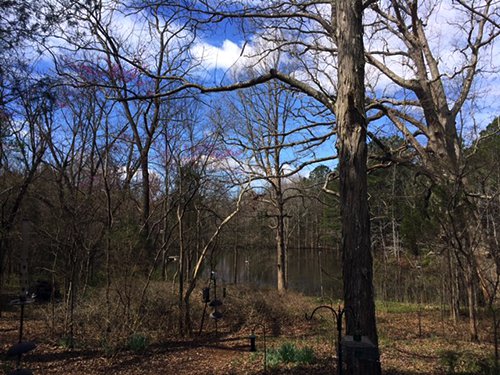
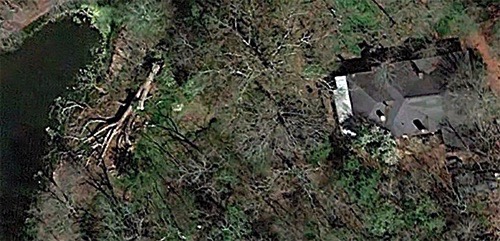
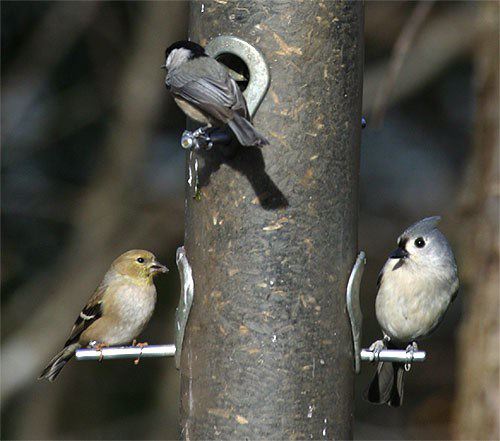

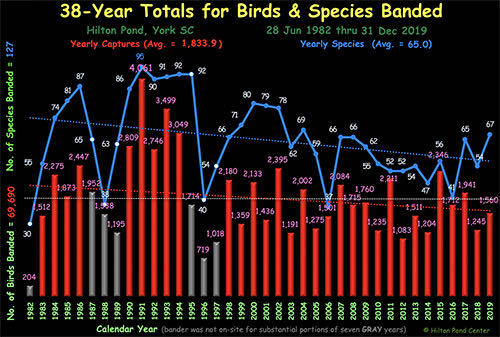
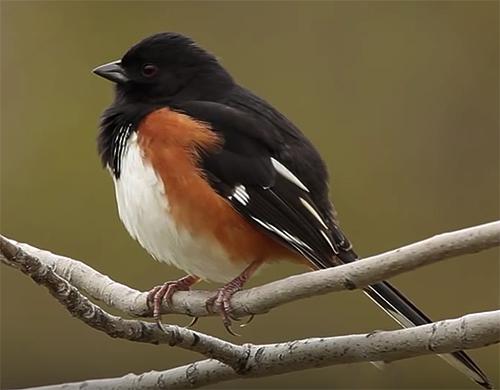
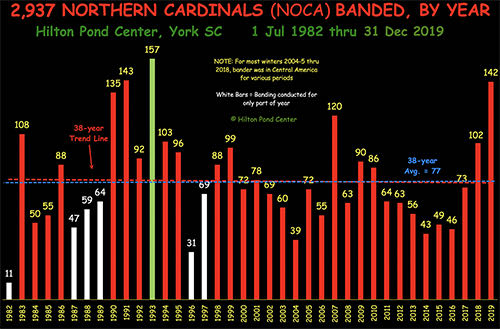
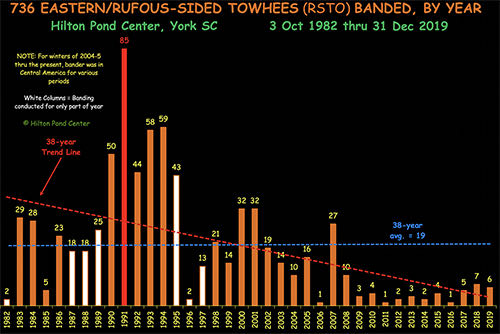
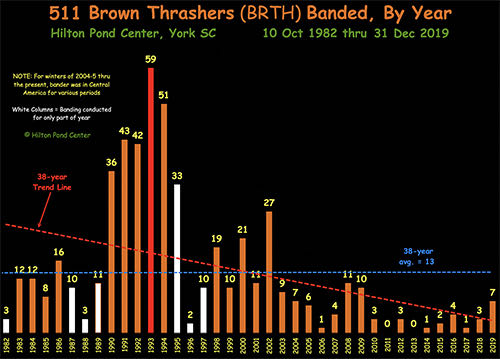

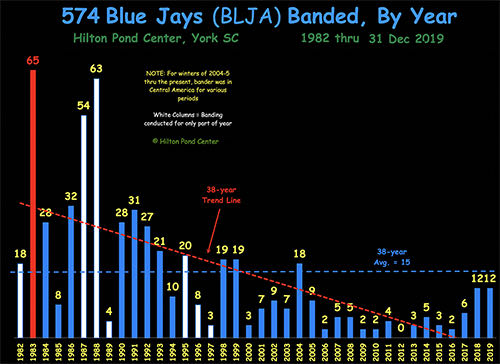
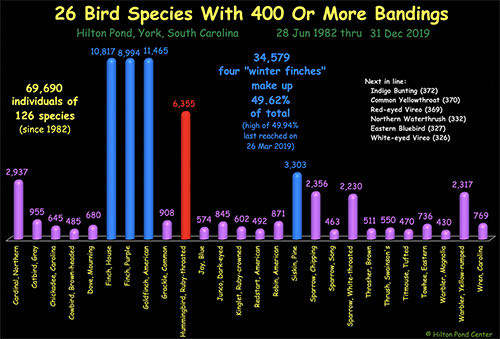
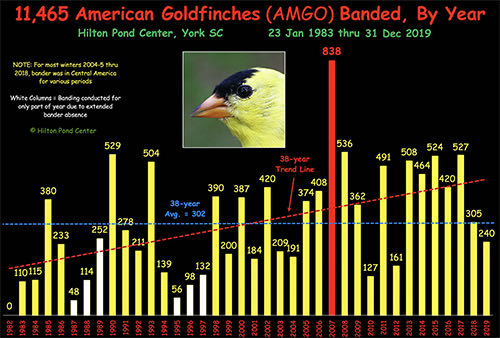
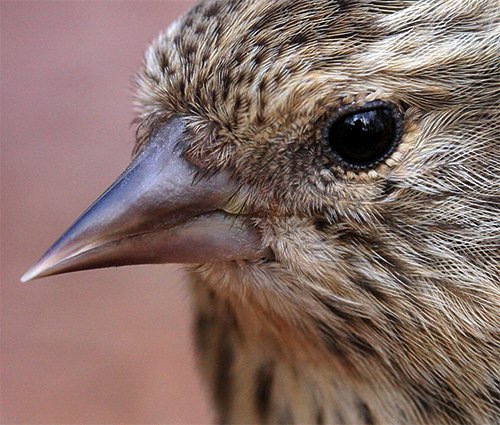
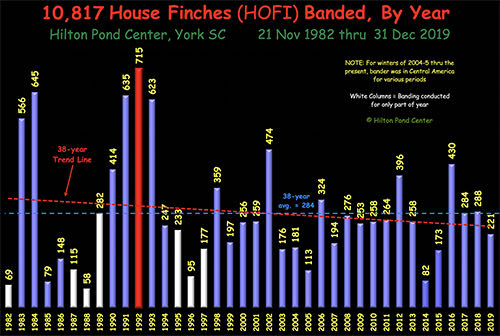
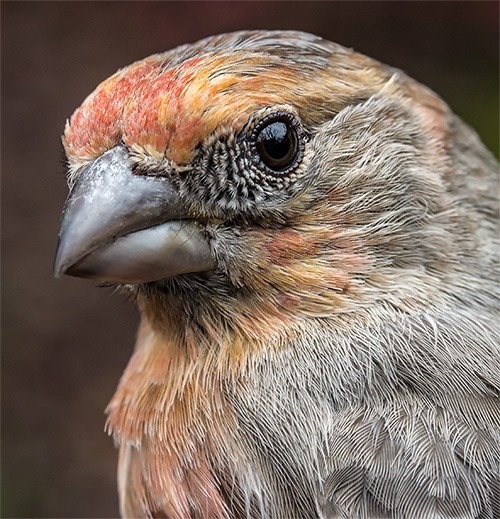
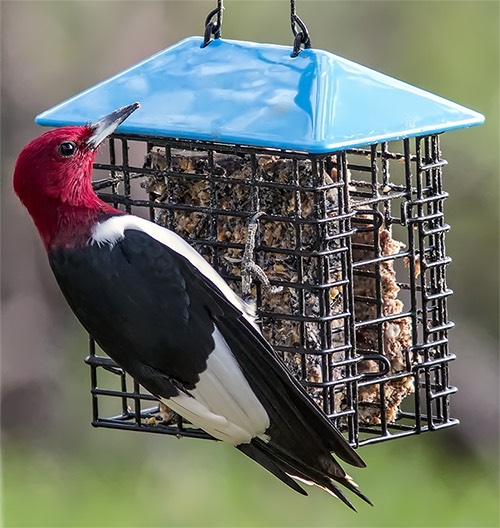
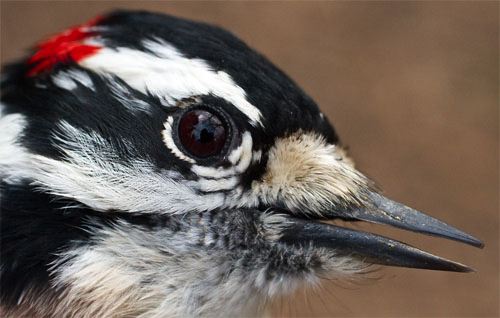
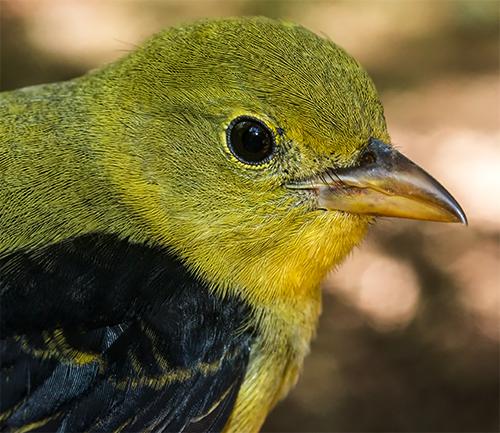
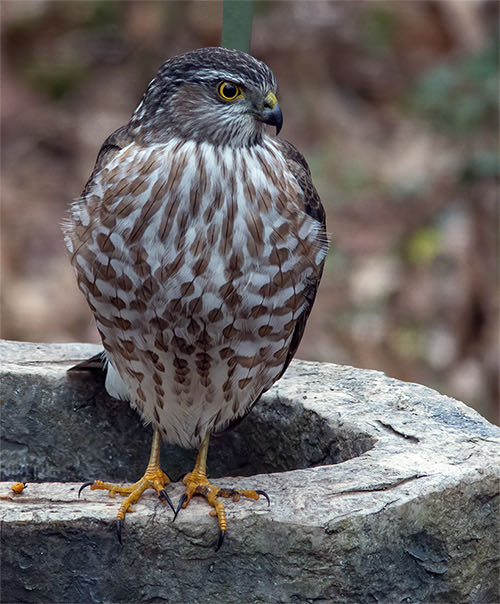
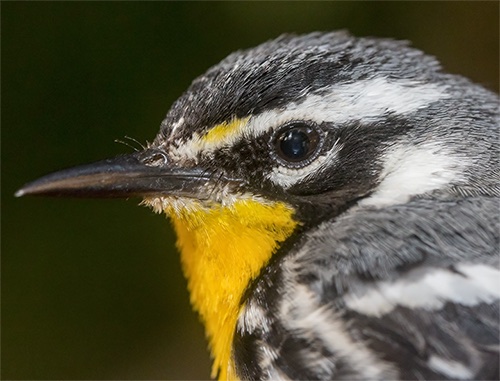

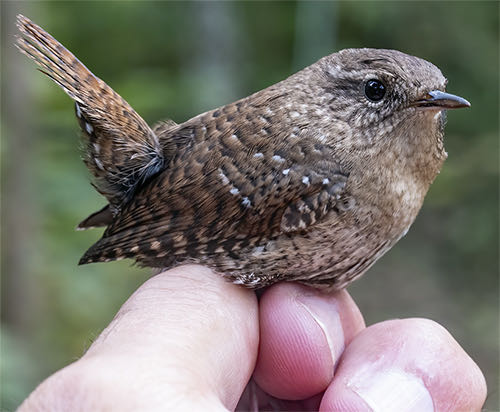


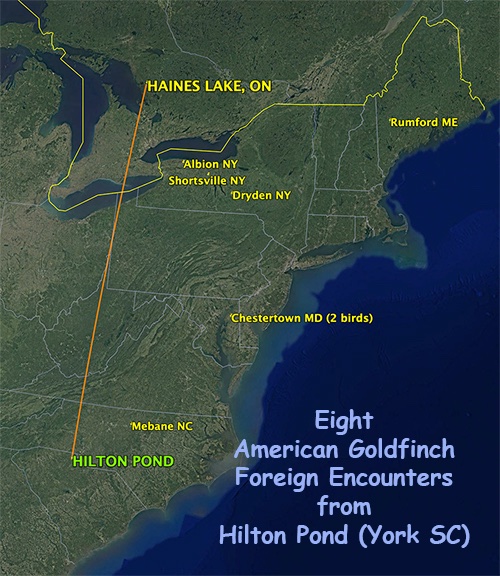




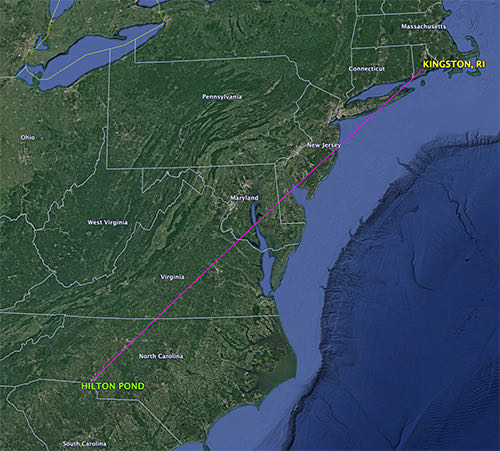

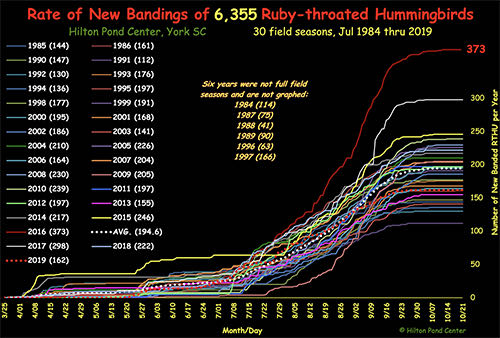

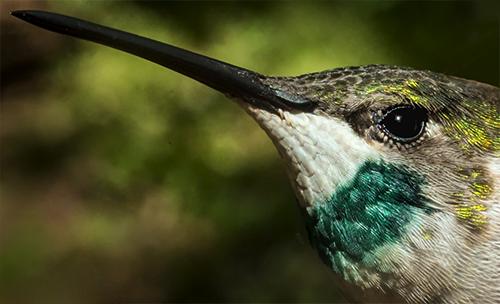

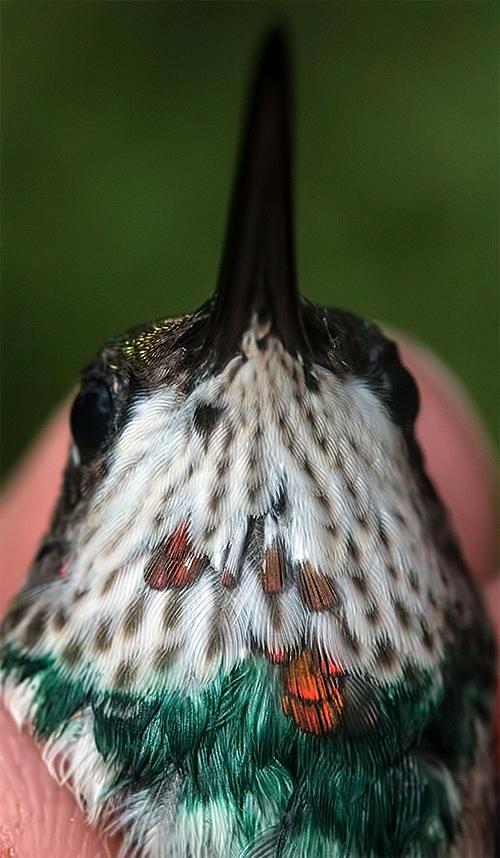
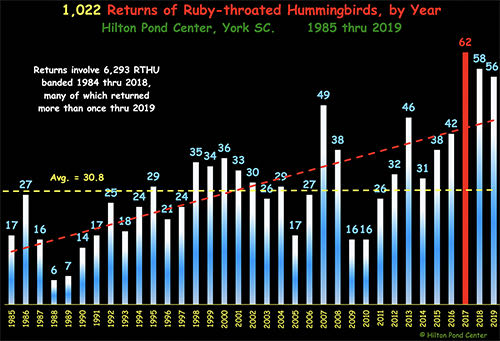
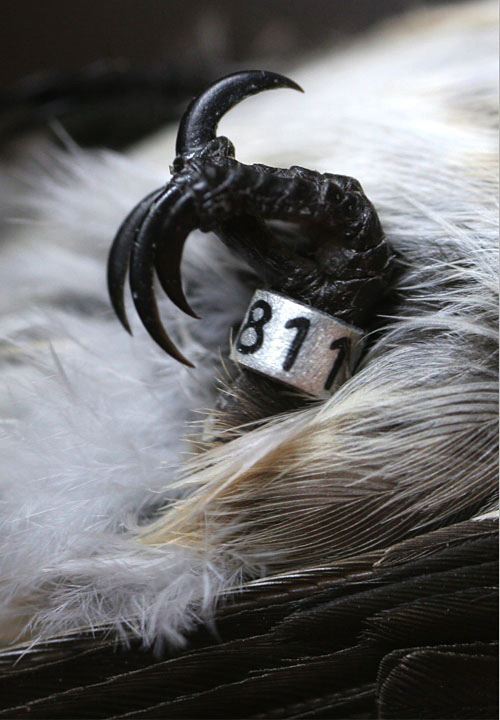

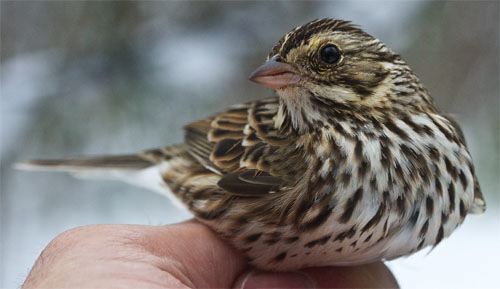
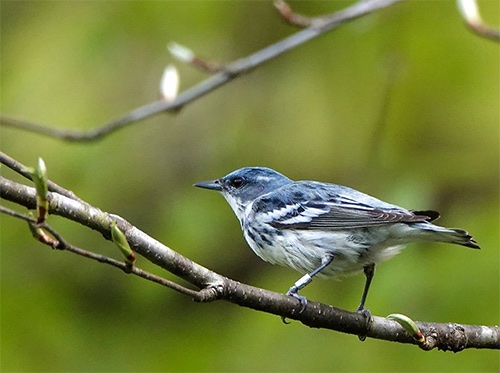
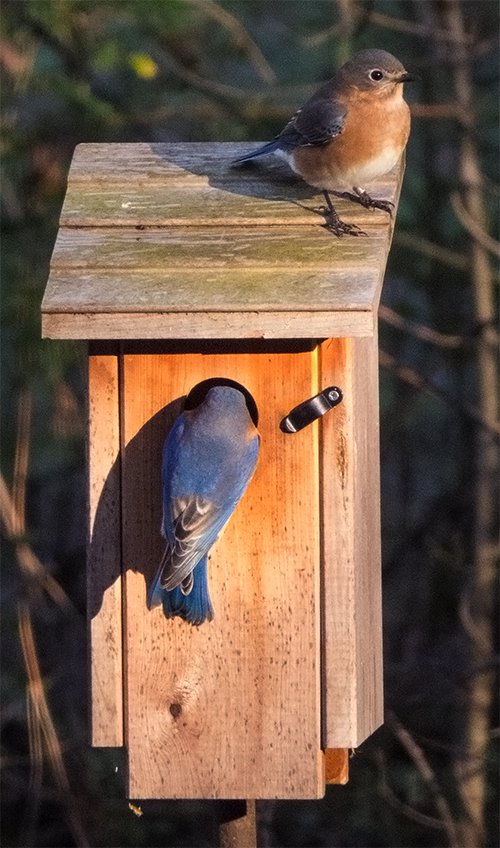










 Oct 15 to Mar 15:
Oct 15 to Mar 15: